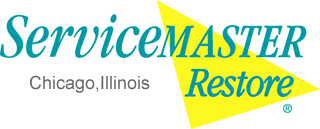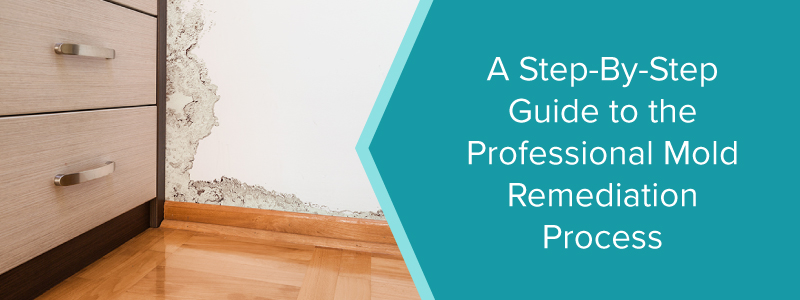What is Mold?
Technically, mold is everywhere. Mold has microscopic spores that float in the air, both indoors and outdoors, and the problem arises when those spores form a colony and grow in your home.
Mold thrives in moist environments. That’s why experts recommend keeping the humidity inside your home or office below 45 percent. But even then, certain areas of your home or building can become more susceptible. If you have a leaky pipe or a damp basement, these areas are going to be the likely culprits of a mold infestation.
The type of mold known as black mold can be especially toxic. The symptoms of black mold poisoning range from the unpleasant, such as sneezing and a runny nose, to far more serious issues such as immunosuppression.
How Do I Know If I Have a Mold Problem?
While a rampaging mold infestation is easy to see, mold grows best in damp, dark places, such as ventilation ducts or crawl spaces.
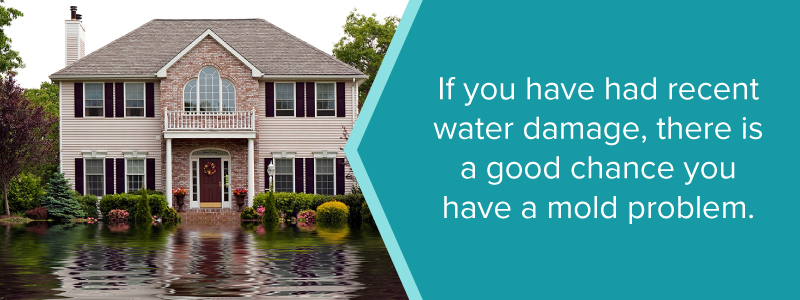
However, if you have had recent water damage, there is a good chance you have a mold problem. That’s because moisture combined with certain organic compounds found in both drywall and insulation make a great home for mold. That’s why when you do have water damage, experts generally recommend that the section of damaged drywall or plaster be completely replaced, rather than painted over.
Many people notice the musty smell associated with mold before they see the mold itself. If you do smell a musty, damp odor, especially coming from your forced-air ducts, you should have a professional inspect the area to determine if mold is the culprit.
Furthermore, if you are experiencing tenacious respiratory issues, and you don’t feel like a standard cold is to blame, know that mold could be the cause. Again, considering the long-term health issues associated with mold infestation, it is wise in such cases to have a professional investigate.
Contact ServiceMaster of Lincoln Park for Mold Remediation >>
Symptoms of Mold:
Typically, your eyes and nose can be used to hone in on mold contamination, although that is not always the case. Symptoms of mold within a building may include:
- Inexplicable presence of musty odors. You may become accustomed to these after living with them for a while, so make sure you pay attention if other people notice these types of smells. They are not as “in tune” to the odor as you might be.
- Colored, fuzzy or slimy blotches on walls or other surfaces. These can be any color, including white, grey, brown and black. Black mold is especially dangerous, so please call a professional right away
- Water stains on walls, ceilings or other surfaces. Many people do not realize water stains may indicate there is mold and mildew growing on the walls, ceilings or floors.
- Excessive moisture and/or water damage that’s been present for over 48 hours. Even if you clean up water that has spilled, it may have seeped into cracks, causing a build-up of moisture-loving bacteria.
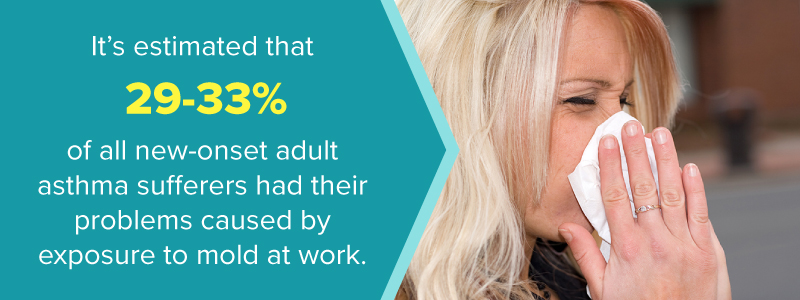
When Mold Attacks: The Sights, Smells & Side-Effects
Beyond the grotesque appearance of mold growth and the foul odors emitted by active mold colonies, inhabitants of mold-infested structures may also face allergic reactions – itchy eyes, sneezing and nasal congestion – when exposed to the presence of mold. Depending on the sensitivity of the individual, skin rashes, fever, wheezing or shortness of breath may occur.
Mold Removal vs. Mold Remediation
At ServiceMaster of Lincoln Park, we focus on both mold removal and mold remediation. One solves the symptoms, and the other addresses the problem.
After flooding or other types of water damage, removing any mold that developed is not enough to return your home, office, or rental apartment to a habitable condition. Individual mold spores are too small to see, and they can float through the air unnoticed. The dark-colored spots you identify as mold on your wall or ceiling are entire colonies of mold.
Even if you throw away every surface that is covered by visible mold, you will not eliminate the health threat. Mold spores can linger in the air or on hidden surfaces. When untreated, those spores can grow into much larger infestations of mold.
You can never remove all the mold from your building because mold is everywhere. The goal is to remove the excess build up and prevent the naturally occurring mold from developing into an infestation again. To make your building safe, the visible mold needs to be removed and the entire area remediated.
- Mold Removal: It’s really only half the job. Any type of mold work needs to be done under the right conditions to keep from spreading mold spores throughout the property. Removing all the material that contains visible mold is just the beginning. Mold removal may also include taking out some materials adjacent to the mold, assuming they are also contaminated with mold spores.
- Mold Remediation: This involves mold removal and then a second equally important step. Remediation is the process that treats the remaining surfaces in the affected area so mold cannot grow back. A special solution is used for mold remediation — that solution kills mold spores you cannot see. The mold remediation process also removes mold spores from the air with air scrubbers.
Mold removal gets rid of the mold, but mold remediation prevents it from growing back. Both steps are required to properly clean water damage and return your building environment to the safe living and workspace that it once was.
Professional Mold Remediation Steps
If you have an identifiable mold infestation, a professional restoration company will take a set number of steps to ensure that the problem mold is removed and the area is stabilized, so the mold problem does not return.
The key to safe and effective mold remediation is addressing the problem without inadvertently causing mold spores to spread to another place in the house. This is why relying on a professional is so important. While homeowners may be able to take care of a moldy area with cleaners, chances are good that mold spores will simply relocate.
The steps in the mold remediation process are as follows:
Step 1: Isolate
The first thing a professional will do is isolate the problem area. Depending on the severity, this may involve laying down plastic sheeting while closing doors and windows. However, in very severe cases, they may use polyurethane sheeting to seal doorways and windows. Once the mold removal process has begun, you need to make sure the mold cannot migrate to another place in the home or office.
The mold remediation team will also do what they can to access the infested area directly from the outside, if possible. If there is a crawl space or a basement bulkhead door that allows them to avoid moving through living spaces, this is the route they will take. That’s because they need to perform certain cleanup steps — which we will discuss later — upon exiting the home or building. The shorter the exit route, the easier the cleanup.
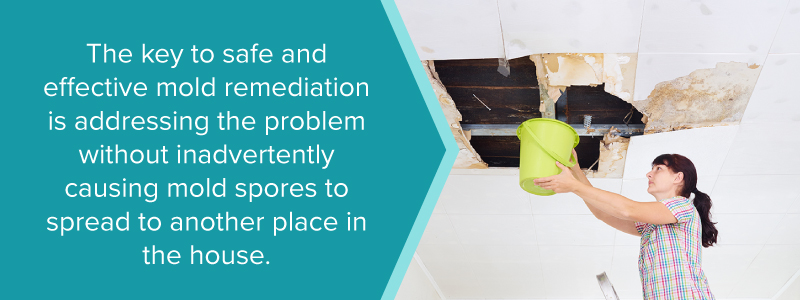
Step 2: Suit Up
For those who don’t know what to expect, a team in head-to-toe white hazmat suits can be a bit shocking. But know that a professional mold remediation team is going to wear this kind of protective gear regardless of the severity of the mold problem. It’s standard procedure.
Booties, goggles and face masks are standard because, during the remediation process, the mold is actually at its most dangerous. While health problems can be caused by a small number of mold spores floating away from an untreated colony, the remediation process will inevitably cause many more spores to be released into the air.
That’s yet another reason why a professional is so important in these situations. An amateur do-it-yourselfer can do a lot of harm by simply sticking their head in the crawl space and brushing the infected area with bleach. If people who work with mold for a living are suiting up this way for just a basic mold remediation assignment, it’s because they know the risks involved.
Step 3: Suppress Dust
While moisture is typically the cause of the problem, a fine mist is a helpful tool during the cleaning process. You are trying to prevent spores from floating through the building and reestablishing themselves somewhere else. A misting will keep dust at bay, thus impeding the spread of the spores.
When it comes to ambient humidity in the building, this fine mist won’t change things drastically. Furthermore, once the cleanup process is finished, the mold remediation team will ensure the room is dry to prevent future mold growth.
Step 4: Remove Contaminated Materials
While certain parts of the home or office will need to be treated, if there is infested drywall or insulation, this needs to be removed.
When it comes to commercial or public buildings, such as school or government buildings, the EPA has strict guidelines on what materials need to be removed and how they should be properly disposed of. It is important that anyone performing mold remediation is familiar with these documents.
There are also guidelines dictating how to package the materials. They need to be placed in plastic bags that are at least six mils thick and double bagged. Once they are tied and sealed, they need to be sprayed down with a disinfecting mist to ensure no spores remain on the outside of the bag.
The removal team will make sure the bags are then taken to the proper place for removal.
Step 5: Scrub and Clean the Remaining Area
Next, the team will begin cleaning those surfaces that could not be removed. This is done through a combination of vigorous scrubbing with a wire brush and specialty single-use cleaning wipes.
Scrubbing is the part of the process when there is the greatest risk of releasing dangerous spores into the air.
That’s why even with smaller jobs, professionals will be suited up. Furthermore, the materials used for cleaning will be disposed of using the same process as the removal of contaminated materials.
Step 6: Apply Biocide
Once all material that can be removed has been taken out of the infected area, and the area is cleaned, the professionals will apply biocide. This is an EPA-approved liquid that kills mold.
It should be noted that the EPA does not approve of bleach as a mold killing agent. While it may be effective on less-dangerous surface molds in your bathtub, it won’t get the job done on the real serious areas.
The biocide also doesn’t work instantaneously. Typically, the team will apply it, and then leave it to do its work overnight.
Again, this is why properly sealing the area is so important. While the area will have already been thoroughly cleaned, there is still a risk of contamination while the biocide works.
Step 7: Encapsulate
After the biocide has been given time to work, the team will use an encapsulating product, which works like a type of whitewash. This will make sure no new mold grows back in the area.
Make sure to spray the product well beyond the area that was initially infested.
Step 8: Clean the Egress
Once the infested area is fully cleaned and sealed, the team will then clean the egress area to make sure any spores that did float away are also eliminated.
If it is a minor mold infestation, mopping the area using specialty detergents will suffice. For major infestations, a HEPA-approved vacuum will need to be used as well.
As the team makes its exit, they will pull up any plastic sheeting or window seals, making sure the step is done with extreme care, to contain any spores that may have landed on the plastic.
Step 9: Dry the Area
To ensure the mold does not return, it is important to dry the area thoroughly. Large fans and dehumidifiers cause moisture to evaporate and then be removed from the air. Additionally, the temperature may be raised to further help with the drying process.
Step 10: Inspect the Area
After the area has dried completely, make sure a final inspection is done to ensure the job was done completely. This involves a thorough visual inspection by someone with a trained eye.
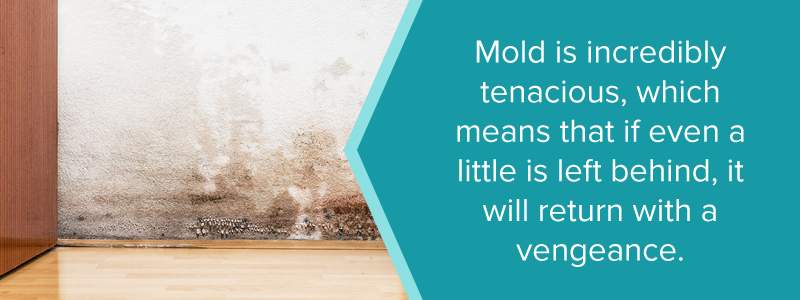
This final step is incredibly important.
Mold is incredibly tenacious, which means that if even a little is left behind, it will return with a vengeance. It must be completely removed to take care of the issue. This is the problem with most do-it-yourself mold removal jobs. It may be possible to remove all the visible mold, but if a small, nearly invisible amount remains, it will require the entire process to be repeated.
Additional Mold Issues for Commercial & Public Buildings
While the cleanup process is much the same in commercial buildings, there is an added importance for those who own or administer the building.
You have a legal responsibility to protect the people who work in or use your building. If you do not address a mold issue, you can expose yourself to litigation.
If you are receiving complaints about SBS or other mold-related respiratory issues, you need to address them immediately. Going through the mold removal and remediation process will protect you from litigation and protect those in your facility.
